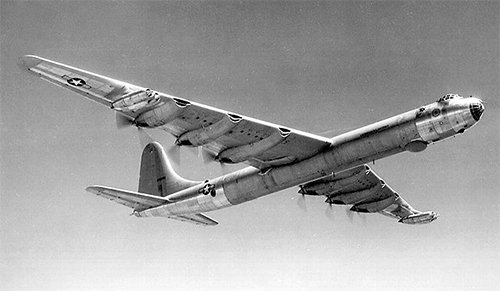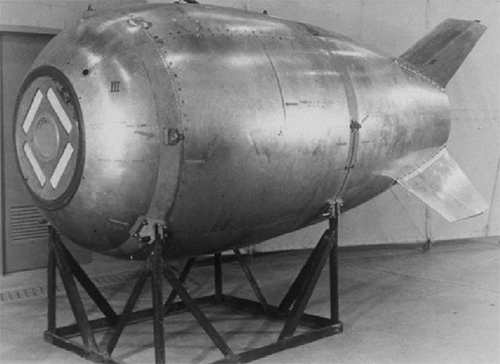
Canadians search for lost 'nuke' near Prince Rupert
Two ton 'dummy' bomb was dropped in 1950
By DAVE KIFFER
November 25, 2016
Friday PM
Ketchikan, Alaska - The Canadian Department of National Defence announced recently that it would like to find the remains of a long-lost relic of the Cold War in the waters off Banks Island, south of Prince Rupert.
In those waters are the pieces of a five-ton Mark IV atomic bomb that was dropped from an American bomber in 1950. The bomb was not armed with nuclear material, but Defence Department officials say this it still could be carrying unexploded ordnance and could pose a threat.
The Prince Rupert website, The Northern View, reported early in November that the Royal Canadian Mounted Police had received a report that a suspicious object was seen underwater in the area where the bomb was thought to have landed. That report is what is causing the Defence Department to send a coastal patrol ship to the area to look for the bomb remnants.

Convair B-36 Peacemaker
The B36 bomber of the US Air Force was the first bomber capable of delivering nuclear weapons.
Courtesy www.wikipedia.org
“The CAF (Canadian Armed Forces) treats reports of suspected unexploded ordnances very seriously and we continue to investigate this matter," National Defence media relations head Daniel Le Bouthillier told the Northern View on Nov. 4. "Information provided by the US Military indicates this was likely a B4 weapon with a dummy capsule carried by the B-36 aircraft that crashed in the vicinity of Prince Rupert on 13 Feb 1950.”
The bomb was dropped from the B-36 after multiple engines caught fire on a training mission between Alaska and Texas. After the bomb was dropped and exploded over the ocean, the 17 crew members parachuted out of the bomber, which then crashed in the mountains near New Hazelton. Twelve of the 17 crew members survived.
Banks Island is located 63 miles south of Prince Rupert, opposite Hecate Strait from Haida Gwaii. It is midway between Prince Rupert and Kitimat by water. Banks Island is approximately 40 miles long and has been the site of a controversial gold mine in recent years
On February 13, 1950, a routine training mission began at Eielson Air Force Base in Fairbanks.
According to a story about the bomb drop on the "Mysteries of Canada" website, a Convair B-36 bomber in the US 436th Strategic Air Command Squadron left Eielson at around 5:25 pm for a flight to its home base at Carswell Air Force base in Fort Worth, Texas.
The plan was to fly south along the Alaskan-British Columbia coast, go inland over Washington State and Montana, then the plane would go on a simulated bombing run to Southern California, head north to San Francisco and then turn and fly to Fort Worth.
The B-36 "Peacemaker" was the largest mass-produced piston engine aircraft ever built with a wingspan of 230 feet and six massive 28-cylinder Pratt & Whitney R-4360 "Wasp Major" radial engines mounted in an unusual "pusher configuration," facing rearward on the wings. It was two-thirds larger than the B-29 and remained in service for most of the 1950s until it was replaced by the jet-engined B-52, although the B-52 was physically smaller than the B-36.

Nuclear Bomb: Mark IV
Courtesy www.wikipedia.org
The B-36 could carry an 80,000-pound payload a maximum of 10,000 miles. But the complicated radial engines also proved to be susceptible to engine fires. This problem was exacerbated by the propellers' facing rearward which increased carburetor icing because the carburetors were forward of the engines and not behind then where they could be engine-heated at high altitude. This was exactly the problem that would lead to the crash of the B-36 near Prince Rupert.
Approximately six hours into the flight, when the B-36 was over the southern Southeast Panhandle, things began to go wrong.
Distress messages from the B-36, picked up by other flights, said it was experiencing icing conditions. The first distress signal came at 11:25 PM. It said the aircraft was in difficulty while flying at 40,000 feet and was descending to 15,000 feet.
Another message reported: “One engine on fire. Contemplate ditching in Queen Charlotte Sound between Queen Charlotte Island and Vancouver Island. Keep a careful lookout for flares or wreckage.”
The icing was also affecting the planes instruments and soon the problem got even worse: two of the engines had caught fire. A third engine had to be feathered, thus the aircraft was flying at half power.
According to the messages, the plane was iced up at even at 15,000 feet. The bomber started to lose altitude, dropping 300 feet a minute. A third engine also caught fire, and then a fourth one stopped because of a plugged fuel line.
The decision was made to abandon and ditch the plane. The crew reported the plane was 90 miles south of Prince Rupert. The radio operator tied down the transmitter key to make it easier for rescue units to track it. A decision was made to jettison the five-ton lead filled atomic dummy in the hold and explode it over the water to prevent any pieces of it from falling into the hands of the Russians who were known to track US atomic flights.
After the third engine died, the plane was put on auto-pilot to head southwest into the open ocean where it would crash.
The 17 crew members abandoned the plane, but only 12 were found. It was assumed that the first five crew members who bailed out landed in the ocean and died of exposure. The 12 survivors landed on islands in the area and were found within days by rescue teams. It was believed that the B-36 had continued into the Pacific, crash landed, and sank.
But the plane pulled a bit of a surprise, the auto-pilot apparently malfunctioned, the plane turned and headed some 200 miles inland from its last known position near Banks Island. It crashed on Kologet Mountain near New Hazelton and was found by a surveyor more than a year and a half later, June 23, 1956. An investigation found that indeed icing in the carburetors had caused the fuel mixture to run "rich" and the engines to catch fire or shut down completely.
Meanwhile, the "bomb," which was the same design as the Fat Man bomb that was used on Nagasaki, had been exploded some 3,000 feet above Hecate Strait near Banks Island. Rather than a nuclear armed core, it had a lead core to simulate the weight of the actual nuclear bomb.
“That particular dummy capsule did not contain any nuclear material and there is no suspected radiological safety hazard from this ordnance," Le Bouthillier told the Northern View. "The Canadian Armed Forces plans to investigate this further using a Maritime Coastal Defence Vessel to investigate more closely in the next 1-2 weeks. The bomb contained lead instead of plutonium, nullifying its catastrophic, destructive power, which in a normal Mark IV 'fat bomb', could have explosive yields of up to 31 kilotons. The bomb had a weight of up to 10,900 pounds.
“The safety and security of Canadians is the Canadian Armed Forces' top priority," He added. "We treat reports of suspected unexploded ordnances very seriously and we work very closely with federal and municipal partners to ensure public safety.”
Even after they were rescued the 12 B-36 crew members had one last trial on the way home. One of the engines of the twin-engined plane they were on caught fire, but the plane landed safely in Fort Worth.
Update:
Navy says, mystery object discovered off B.C. coast is not lost nuke - A mysterious object spotted underwater off the B.C. coast is not a lost bomb believed to have crashed in the area in 1950, Canadian naval officials confirm. - More...
Thursday PM - December 01, 2016
On the Web:
Columns by Dave Kiffer
Historical Feature Stories by Dave Kiffer
Dave Kiffer is a freelance
writer living in Ketchikan, Alaska.
Contact Dave at dave@sitnews.us
Dave Kiffer ©2016
Representations of fact and opinions in comments posted are solely those of the individual posters and do not represent the opinions of Sitnews.
E-mail your news &
photos to editor@sitnews.us
Publish A Letter in SitNews Read Letters/Opinions
Contact the Editor
SitNews ©2016
Stories In The News
Ketchikan, Alaska
|
Articles &
photographs that appear in SitNews may be protected by copyright
and may not be reprinted without written permission from and
payment of any required fees to the proper sources.
|
|

